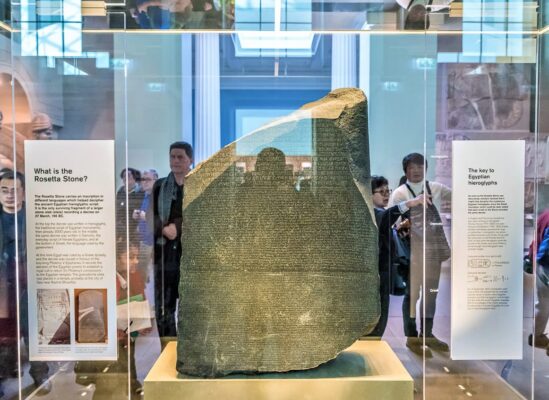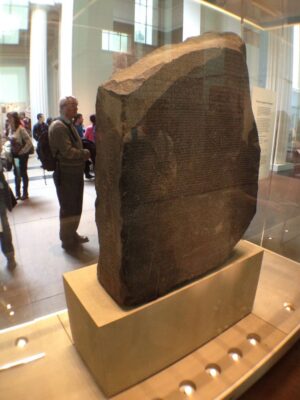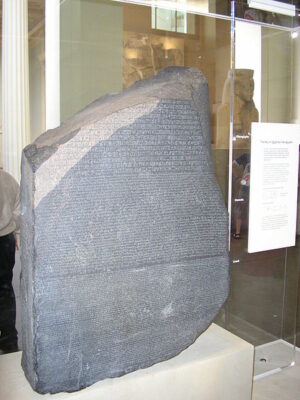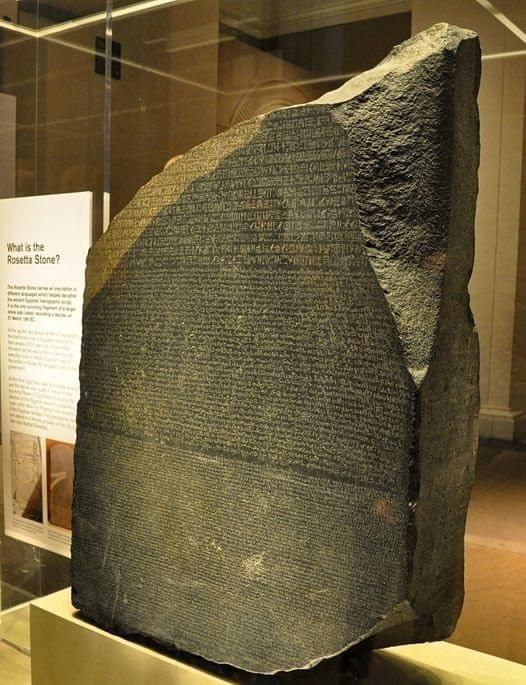The Rosetta Stone, a remarkable artifact discovered in 1799, has been instrumental in unveiling the mysteries of ancient Egyptian civilization. Found by French soldiers in Egypt, this granodiorite stele dates back to 196 BCE and serves as a key to understanding hieroglyphs thanks to its trilingual inscription. Follow archeology.dulichvn.net to discover many hidden mysteries that have yet to be discovered.

Discovery of the Rosetta Stone
When and Where It Was Found
The Rosetta Stone was discovered in the summer of 1799, during Napoleon Bonaparte’s military campaign in Egypt. French soldiers, engaged in fortifying a small outpost near the town of Rosetta (modern-day Rashid) in the Nile Delta, stumbled upon the remarkable artifact. The stone’s unique inscriptions quickly caught their attention, sparking intrigue among scholars and military personnel alike. Its strategic location near Rosetta, a bustling port town at the time, contributed to its preservation and eventual rediscovery.
Significance of the Discovery
From the moment it was unearthed, the Rosetta Stone was recognized as a potential key to solving one of the greatest linguistic mysteries of the ancient world. Its trilingual inscription—written in Greek, Demotic, and Hieroglyphic scripts—provided scholars with a rare opportunity to decode the long-lost language of ancient Egyptian hieroglyphs. The stone’s content promised not just linguistic breakthroughs but also deeper insights into the cultural, political, and religious life of ancient Egypt.
Journey to Fame
After its discovery, the Rosetta Stone quickly became a symbol of scholarly and national pride. It was initially studied by French scholars, but the defeat of Napoleon’s forces in Egypt led to the artifact being handed over to the British under the terms of the Treaty of Alexandria in 1801. Transported to England, it was presented to King George III and subsequently entrusted to the British Museum, where it has been on display since 1802. Over the centuries, the Rosetta Stone has become one of the museum’s most visited and celebrated exhibits, continuing to captivate audiences worldwide with its historical significance and the story of its remarkable journey.

The Trilingual Inscription
The Three Scripts Explained
The text on the Rosetta Stone is written in three distinct scripts: Greek, Demotic, and Egyptian Hieroglyphs. Each of these scripts served a specific function, reflecting the social and cultural hierarchy of ancient Egypt during the Ptolemaic period.
- Greek was the language of the ruling elite and the administrative class, used by the Greek-speaking Ptolemaic dynasty and their officials.
- Demotic was the script of everyday communication, employed by the common people for administrative and legal matters.
- Hieroglyphs, the most sacred of the three, were reserved for religious and ceremonial texts, often used in temples and royal inscriptions to honor the gods and kings.
These three scripts together showcase the different layers of society and the roles language played in governance, daily life, and religion in ancient Egypt.
The Content of the Text
The inscription on the Rosetta Stone is a royal decree issued in Memphis by a council of priests during the reign of King Ptolemy V. The decree commemorates the king’s generosity and his commitment to improving the welfare of Egypt’s temples and people. It outlines a series of benefits and privileges granted to the Egyptian temples, as well as a general amnesty for the people. This decree reflects the king’s attempt to solidify his rule and garner support from both the priesthood and the common people.
Why Three Scripts?
The use of three scripts in the inscription was not merely decorative; it was a practical decision aimed at ensuring the decree was accessible to a wide range of people across Egyptian society. Greek, as the language of the ruling class, ensured the message was understood by the Ptolemaic administration.
Demotic was widely used by the general populace for everyday matters, ensuring that the common Egyptians could understand the royal pronouncements. Hieroglyphs, reserved for sacred and official texts, connected the decree to the divine authority of the king, emphasizing its religious and ceremonial importance. This multilingual approach reflects the diverse and multicultural nature of Ptolemaic Egypt, where different linguistic and cultural groups coexisted and needed to be addressed in their own languages.

Deciphering Ancient Hieroglyphs
The Role of the Rosetta Stone
The Rosetta Stone played a transformative role in the history of linguistics and Egyptology. Before its discovery, Egyptian hieroglyphs had been an enigma, their meanings lost to time. The stone’s parallel inscriptions in Greek, Demotic, and Hieroglyphs provided a crucial key—a linguistic bridge—that ultimately unlocked the secrets of ancient Egyptian writing. It became the cornerstone for deciphering a language that had been indecipherable for over a millennium.
Key Figures in Decoding
The breakthrough in understanding the Rosetta Stone’s inscriptions is largely attributed to Jean-François Champollion, a French linguist and scholar. Building on earlier attempts by others, such as Thomas Young, Champollion meticulously compared the Greek text with the hieroglyphic script. He identified that hieroglyphs were not merely symbolic but often phonetic, representing sounds rather than abstract concepts. In 1822, Champollion announced his findings, effectively cracking the code of hieroglyphic writing. His work marked a monumental step forward in deciphering ancient languages.
Impact on Egyptology
The ability to read hieroglyphs revolutionized the field of Egyptology. Scholars could now directly access and interpret the vast corpus of texts inscribed on temples, tomb walls, stelae, and papyri. This newfound understanding shed light on the religion, governance, daily life, and cultural practices of ancient Egypt, offering a detailed picture of one of history’s most iconic civilizations. The Rosetta Stone’s impact extended beyond Egyptology, influencing the study of ancient scripts worldwide and cementing its legacy as one of the most important archaeological discoveries of all time.
See more: The Fontaines de la Concorde: A Masterpiece of Parisian Elegance
Conclusion
The Rosetta Stone remains one of the most significant archaeological discoveries in history. As a bridge to the past, it not only revealed the secrets of hieroglyphs but also opened a window into the rich and complex world of ancient Egypt. Today, it continues to inspire curiosity and scholarly exploration.


CÁC TIN KHÁC
Mary Walton: The Forgotten Inventor Who Helped Clean Up America’s Cities
Tomb of Queen Nefertari in the Valley of the Queens, Egypt
Discover the Hypostyle Hall of the Temple of Hathor at Dendera
Venus de Losange: Unveiling the Mystery of a 20,000-Year-Old Paleolithic Icon